
The City of Cañon City is the home rule municipality that is the county seat and the most populous municipality of Fremont County, Colorado, United States. The city population was 17,141 at the 2020 United States Census. Cañon City is the principal city of the Cañon City, CO Micropolitan Statistical Area and is a part of the Front Range Urban Corridor. Cañon City straddles the easterly flowing Arkansas River and is a popular tourist destination for sightseeing, whitewater rafting, and rock climbing. The city is known for its many public parks, fossil discoveries, Skyline Drive, The Royal Gorge railroad, the Royal Gorge, and extensive natural hiking paths. In 1994, the United States Board on Geographic Names approved adding the tilde to the official name of Cañon City, a change from Canon City as the official name in its decisions of 1906 and 1975. It is one of the few U.S. cities to have the Spanish Ñ in its name, others being La Cañada Flintridge, California; Española, New Mexico; Peñasco, New Mexico; and Peñitas, Texas.

Sugar Hill is a National Historic District in the Harlem and Hamilton Heights neighborhoods of Manhattan, New York City, bounded by West 155th Street to the north, West 145th Street to the south, Edgecombe Avenue to the east, and Amsterdam Avenue to the west. The equivalent New York City Historic Districts are:
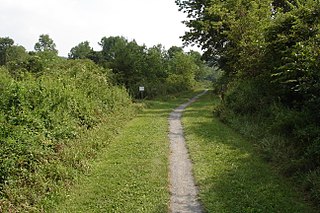
Jacobsburg Environmental Education Center is a 1,168-acre (473 ha) Pennsylvania state park near Wind Gap, in Bushkill Township, Northampton County in Pennsylvania, in the United States. The Jacobsburg National Historic District is almost entirely surrounded by the park. Jacobsburg Environmental Education Center is just off the Belfast exit of Pennsylvania Route 33.

This is a list of the National Register of Historic Places listings in Dakota County, Minnesota. It is intended to be a complete list of the properties and districts on the National Register of Historic Places in Dakota County, Minnesota, United States. Dakota County is located in the southeastern part of the U.S. state of Minnesota, bounded on the northeast side by the Upper Mississippi River and on the northwest by the Minnesota River. The locations of National Register properties and districts for which the latitude and longitude coordinates are included below, may be seen in an online map.

This is a list of the National Register of Historic Places listings in Chesterfield County, Virginia.

The U.S. Post Office in Albion, New York, is located on South Main Street in the center of town. It serves the 14411 ZIP Code, covering the village and town of Albion plus neighboring sections of the towns of Barre and Gaines.

Erie Freighthouse Historic District is a national historic district located at Bath in Steuben County, New York. It is composed of all or portions of seven properties, including the former Erie Railroad freighthouse, various buildings for the sale or storage of agricultural goods, and the former Bath Harnass Company factory.

Brown's Race Historic District is a national historic district located at Rochester in Monroe County, New York. The district contains 15 contributing buildings, 2 contributing structures, and 14 contributing sites. All of the principal buildings are used for commercial purposes and are sited along or near the curving south rim of the Genesee River gorge at the rim of the High Falls. The district comprises a collection of 19th-century industrial buildings built of brick and stone, and ranging in size from one- to six-stories. Also in the district is the mill race and the 19th century iron Pont De Rennes bridge, which is used today as a pedestrian bridge and viewing platform of the High Falls and surrounding gorge.

Fly Creek Methodist Church, also known as First Methodist Episcopal Society in Fly Creek, is a historic Methodist church on County Route 26, north of the junction with conjoined NY 28 and NY 80 in Fly Creek, Otsego County, New York. It was built in 1838 and is a plain, clapboarded, timber-frame building on a fieldstone foundation with a frontal gable in the Greek Revival style. The interior configuration is a modification of the Akron plan. It is located within the boundaries of the Fly Creek Historic District.
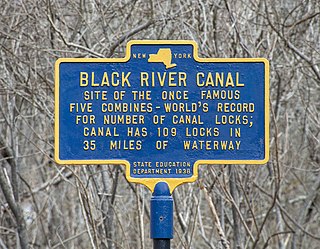
Five Lock Combine and Locks 37 and 38, Black River Canal is a national historic district located in the Boonville Gorge Park at Boonville in Oneida County, New York. The district includes seven locks of the abandoned Black River Canal, including the five lock combine. The locks are 90 by 15 feet and could accommodate boats of 70 tons. The original locks were built about 1850 and rebuilt between 1887 and 1900. The canal closed in 1924.
Fly Creek Historic District is a national historic district located at Fly Creek in Otsego County, New York.

Central Campus is the primary academic and administrative section of Cornell University's Ithaca, New York campus. It is bounded by Libe Slope on the west, Fall Creek on the north, and Cascadilla Creek on the South.

Ithaca Falls is a waterfall located within the city of Ithaca, New York. It is the last of a series of waterfalls along the hanging valley formed where Fall Creek intersects the glacial trough of Cayuga Lake. The falls are in an amphitheater formed by freezing and thawing of the weak shale which makes up most of the gorge walls. The splash pool, and the creek just below the falls, are a popular spot for fly fishing.

Fredella Avenue Historic District is a national historic district located at Glens Falls, Warren County, New York. It includes eight contributing buildings. They are multi-story concrete residential buildings built as speculative housing for Italian immigrant families. They are built of molded concrete block and decorated with cast concrete trim and characterized by two story porches with concrete fluted columns. They were built between 1914 and 1918 and located based on their proximity to local stone quarries.
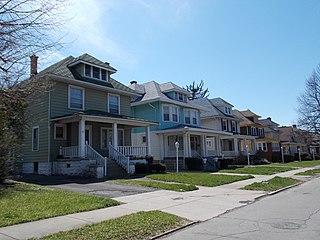
Hamlin Park Historic District is a national historic district and neighborhood located at Buffalo in Erie County, New York. The district encompasses 1,368 contributing buildings, 3 contributing sites, and 6 contributing structures in a predominantly residential section of Buffalo. The district includes a variety of residential buildings built primarily between about 1895 and 1930, and later improved through Model Cities Program grants between 1966 and 1975. It includes a variety of pattern book houses in popular architectural styles of the late-19th and early-20th century, with some interspersed Bungalow / American Craftsman style dwellings. Located in the district are the separately listed Robert T. Coles House and Studio and Stone Farmhouse. Other notable buildings include the Lutheran Church Home (1906), the former Second United Presbyterian Church (1920), and the former St. Francis DeSales Roman Catholic Church (1926).
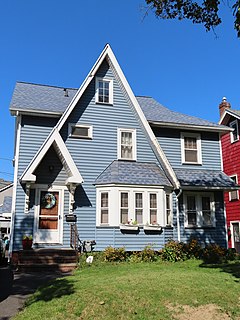
Arvine Heights Historic District is a national historic district located at Rochester, Monroe County, New York. The district encompasses 61 contributing buildings in an exclusively residential section of Rochester. The district developed between about 1920 and 1942, and includes residential buildings in a variety of architectural styles including Colonial Revival, Tudor Revival, and Bungalow / American Craftsman. The dwellings reflect modest designs directed toward a middle-class clientele in a newly developing area of Rochester's Nineteenth Ward.

Chili–West Historic District is a national historic district located at Rochester, Monroe County, New York. The district encompasses 508 contributing buildings in a predominantly residential section of Rochester. The district developed between about 1874 and 1935, and includes buildings in a variety of architectural styles including Queen Anne, Colonial Revival, Gothic Revival, and Tudor Revival, Mission Revival, and Bungalow / American Craftsman. The dwellings reflect designs directed toward a middle-class and working class clientele in a newly developing area of Rochester's Nineteenth Ward. Located in the district is the former St. Augustine Roman Catholic Church complex.
Elmwood Historic District–East is a national historic district located at Buffalo, Erie County, New York. The district encompasses 2,405 contributing buildings, 31 contributing structures, and 14 contributing objects in the Elmwood Village neighborhood of Buffalo. It is bounded on the north by Delaware Park, Forest Lawn Cemetery, and the former Buffalo State Asylum, on the south by the Allentown Historic District, and on the west by the Elmwood Historic District–West. This predominantly residential district developed between about 1867 and 1965, and includes notable examples of Queen Anne, Shingle Style, Colonial Revival, Tudor Revival, and American Craftsman style architecture. The district contains one of the most intact collections of built resources from turn of the 20th century in the city of Buffalo and western New York State. Located in the district are 17 previously listed contributing resources including the Buffalo Seminary, Garret Club, James and Fanny How House, Edgar W. Howell House, Edwin M. and Emily S. Johnston House, Col. William Kelly House, Lafayette Avenue Presbyterian Church, Parke Apartments, and the Unitarian Universalist Church of Buffalo. Other notable building include the Frank Lloyd Wright designed William R. Heath House (1904-1905), Herbert H. Hewitt House, School 56 (1910-1911), the Harlow House, A. Conger Goodyear house, Alexander Main Curtiss House, Nardin Academy campus, and Coatsworth House (1897).

Brendonwood Historic District, also known as Brendonwood Common, is a national historic district located at Indianapolis, Indiana. It encompasses 85 contributing buildings, 2 contributing sites, and 1 contributing object in a planned suburban residential section of Indianapolis. 350 acres on the eastern edge of Millersville with Fall Creek as the western boundary was the vision of Charles S. Lewis for a self-regulated residential zone of 110 plots. Noted landscape architect George E. Kessler was hired to develop the planned community. The district developed between about 1917 and 1954, and includes representative examples of Tudor Revival, Colonial Revival, and Bungalow / American Craftsman style architecture. Notable contributing resources include the Common House (1924), golf course, Two Knolls (1951-1952), Farlook (1939), Springhead (1934), Dearwald (1927), Wancroft (1940), Larkwing (1952), Grasmere (1937-1938), Wetermain (1921), Whispering Trees (1952-1953), Glen Gate (1922-1923), Witching View (1928-1929), Long Ridge (1923-1924) and Great Maple (1948).
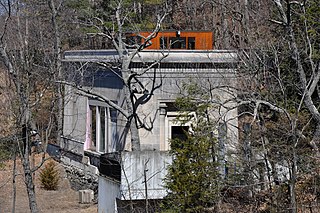
900 Stewart Avenue is a building in Ithaca, New York, noted for its unique Egyptian Revival architecture, its dramatic placement partway down a cliff, and being the residence of astronomer Carl Sagan. The building is on a ledge about 50 feet (15 m) below street level, overlooking Fall Creek and Ithaca Falls.






















